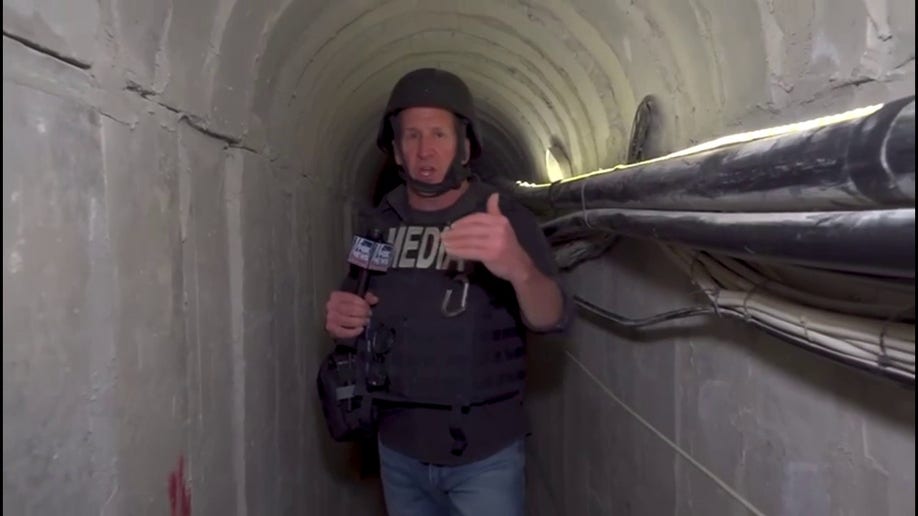
Reporter’s Notebook: Embedded with the IDF deep inside Hamas tunnels under UNRWA HQ

There was not a lot of dialogue with the Israeli Defense Forces contacts before this embed happened. After four months of this war, they have the drill down to a system and the IDF had something they wanted to show the outside world.
We loaded up onto Humvees. A soldier stood in the front seat, one hand on the roll bar, the other on an automatic weapon mounted to the hood. At my left elbow was an Israeli version of a shoulder-mounted rocket as well as a spare rifle.
For the first 10 minutes of the trip, we were still in Israel. We traveled on the pavement. The closer we got to the Gaza Strip, the road got rougher where the sides had been broken up by heavy armored vehicles. Camps began to appear where soldiers waited outside the fence for their orders to return to combat.
Once we passed the fence into Gaza, the landscape showed only destruction. I didn’t see a building or structure that wasn’t damaged. Most were flattened.
The drivers went breakneck over the twisted and potholed sand roads until we arrived at the camp for the 401st armored division in the Gaza Strip. Soldiers waited on plastic chairs between their vehicles. A few had wandered to the beach to take pictures. Some did maintenance on the big Merkava tanks.
We did not stay long. We transferred into an Israeli Namer, armored personnel carrier, for the trip to the Shati refugee camp, just north of the population center of Gaza City. Reports of Hamas fighters regrouping in Gaza City created a reasonable risk of an ambush, despite Israel’s firm control of the area.
When we climbed out of the armored vehicle at Shati, I could see 360 degrees of destruction. Piles of dirt and broken concrete. All roads and sidewalks were broken. Everywhere we traveled was a matter of hiking up and over piles of sand, either leftover from an explosion or churned up by tanks. Some of the large apartment buildings were still standing, but black smoke stains streaked upward out of most windows. Occasionally, we would hear the large crack of new airstrikes in the area or machine-gun fire.
The first place reporters were taken to was a kindergarten, made obvious with paintings of SpongeBob and other cartoons on the walls. Lt. Col Idor of the 401st armored brigade showed the reporters maps of where the tunnels stretched beneath us. Then we loaded back in the armor and drove to the UNRWA headquarters, where soldiers had dug a well straight down to one of the rooms that served as a hub for electricity in the tunnel. The lieutenant colonel pulled the Velcro press identifier off my body armor and dropped it down the hole. ‘You’ll get this later,’ he said.
We were shown two rooms in the UNRWA headquarters where wiring for computers, communications equipment and electricity went straight underground. Then, ultimately, taken back to the area of the kindergarten to the safest tunnel entrance.
We had to get on hands and knees and crawl for a bit at the start of the tunnel. Once inside, we could stand and walk. Sometimes, when the ceiling wasn’t high enough, we crouched. Sometimes, when it was bad enough, we crawled again. At a few points, we hiked through water that was probably filthy.
The tunnels are dramatically different than the ones I crawled in under the border with Egypt more than a decade ago. The modern ones are reinforced with concrete. There is concrete underfoot. At some locations Hamas spent the effort to tile the tunnels and the rooms built off to the side. They had working plumbing and modern toilets. The tile work was good. In one location, it looked like Hamas had built a coffee shop, where they could take a break, because the decorative tile was all about coffee.
We hiked probably less than a half mile, arriving underneath the UNRWA headquarters, where I recovered my press identifier. Lt. Col Idor showed us a room 25 feet deep filled with computer servers, another room with communications equipment and still another that was an electrical junction for the tunnels. All of it connected to the headquarters building above with extensive wiring.
The soldiers made the point, there was no way Hamas could have installed all of that, made the construction noise, and moved truckload after truckload of dirt out of the tunnels without UNRWA employees being aware.
‘Our problem is the Hamas,’ said Lt. Col Idor. ‘Hamas working in the UNRWA and under the UNRWA.’
UNRWA released a statement saying they are a humanitarian organization without the capability or expertise to conduct ‘military inspections’ of what might be under its premises.




